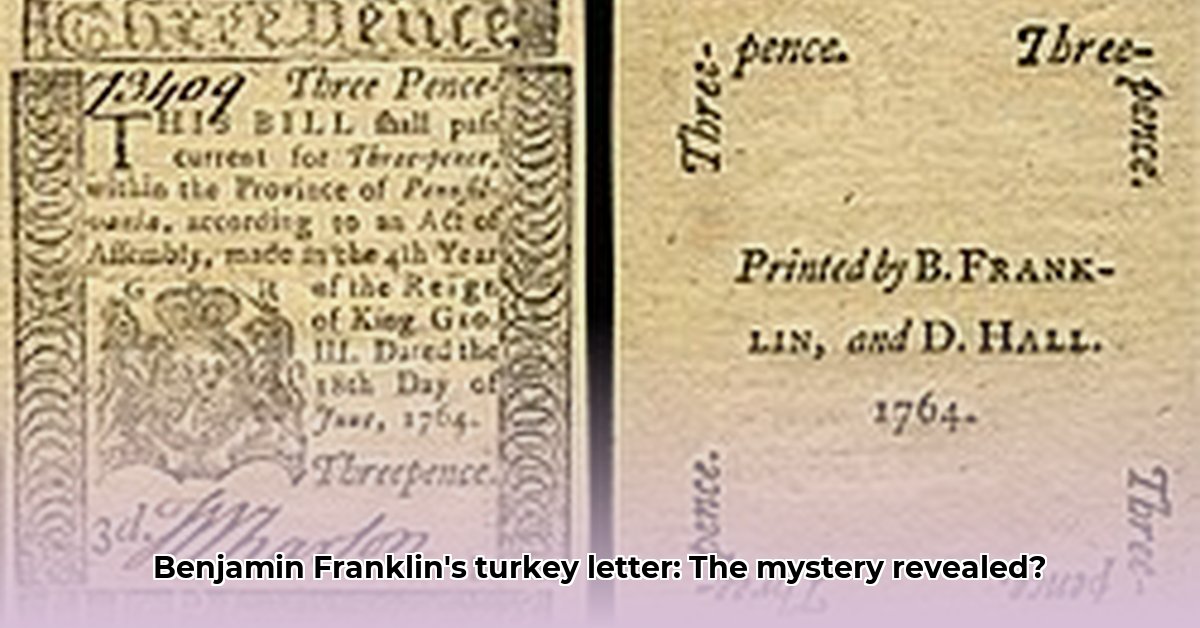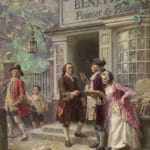Have you ever encountered the whimsical claim that Benjamin Franklin championed the turkey, not the bald eagle, as America’s national bird? It’s a captivating anecdote, yet to what extent does it reflect historical reality? The truth proves far more nuanced than a simple affirmation or denial, illustrating how an engaging narrative can evolve and distort our understanding of the past. For a fascinating look at how myths evolve, see this exploration of Tolkien’s Middle-earth Tolkien’s Mythology. Join us as we dissect the story behind Franklin’s “turkey letter,” scrutinizing the evidence, exploring diverse interpretations, and tracing the intriguing journey of this misunderstanding into American folklore.
A Thanksgiving Anecdote Unveiled: Dissecting the Historical Puzzle
Envision this scenario: Thanksgiving dinner, the turkey takes center stage, and someone casually asserts that Benjamin Franklin advocated for the turkey over the bald eagle as America’s national symbol! A preposterous notion, isn’t it? This seemingly innocuous tidbit forms the crux of a longstanding historical enigma. Did one of the Founding Fathers genuinely propose a plump turkey on our national seal, or is this a gross misrepresentation of history? The reality, as you’ll discover, is more intricate than any cranberry sauce recipe. What elements have contributed to the story’s enduring appeal, and can we ever definitively ascertain Benjamin Franklin’s true intention?
A Nascent Nation, A Symbol in Search: The Quest for American Identity
In the aftermath of the Revolutionary War, the nascent United States faced a pivotal question: what emblem would best represent the newborn nation? This choice extended beyond mere aesthetics; it was about encapsulating the very essence of America. The bald eagle emerged as a leading contender, yet its ascent wasn’t without obstacles. The Society of the Cincinnati, a group of Revolutionary War officers known for their aristocratic leanings, ignited controversy with their symbolic preferences, further complicating matters. This set the stage for a misunderstanding of legendary proportions. Why was the selection of a national symbol laden with tension, and what values did each contender embody in early America?
The Letter Unveiled: Jest or Earnest Plea?
At the heart of this enigma lies a letter penned by Benjamin Franklin himself. While the exact recipient remains debated, with some suggesting his daughter and others a French intellectual, the content is clear. In this letter, Franklin playfully juxtaposes the bald eagle with the wild turkey, suggesting the latter is a “more respectable bird.” This seemingly straightforward comparison sparks the central debate. Was it a private jest, a veiled jab at the Society of the Cincinnati’s perceived arrogance, or a genuine endorsement of the turkey? The letter, imbued with Franklin’s characteristic wit, yields only clues, leaving historians to ponder. What was Benjamin Franklin’s intended tone in the letter, and how has it influenced subsequent interpretations?
A Clash of Interpretations: Historians Debate the Turkey’s Merits
Historians remain deeply divided on the letter’s true intent. Some interpret Franklin’s remarks as purely satirical, a subtle jab at the Society’s pretentiousness, subtly criticizing their aristocratic leanings while subtly supporting the eagle. Other historians, however, propose a different view, suggesting Franklin genuinely favored the turkey, emphasizing its indigenous American roots and more dignified demeanor. This debate has persisted for years. As articulated by [Dr. Gordon Wood, Alva O. Way University Professor of History Emeritus], [Professor] at [Brown University], “Franklin often used humor as a vehicle to convey more serious political observations.”
Beyond Ornithology: Symbolism and Contextual Nuances
To fully grasp the situation, we must consider the broader historical context. Franklin played an active role in designing the Great Seal of the United States, and, significantly, the eagle was ultimately chosen. This presents a notable contradiction – or, perhaps, a more nuanced depiction of his views. Understanding the prevailing use of satire in 18th-century discourse is paramount. Was Franklin, a master of wit, employing a common literary device to convey a hidden message? The deeper you delve, the more intricate the issue becomes. What role did satire play in 18th-century communication, and how does it inform our understanding of the “turkey letter?”
Charting the Evidence: Clues, Conflicts, and Continuing Debate
Let’s summarize the evidence, highlighting the critical aspects of this puzzle:
| Evidence | Advocates “Turkey as National Bird” | Advocates “Satirical Remark” |
|---|---|---|
| Tone of the Letter | Appears earnest (though possibly sarcastic) | Clearly playful and lighthearted |
| Franklin’s Other Writings | Some ambiguous passages | Primarily supports the eagle |
| Historical Context | Potential motivation exists | Explains Franklin’s actions nicely |
| Great Seal’s Design | Appears to contradict the letter | Provides essential background |
The mystery surrounding Benjamin Franklin’s turkey letter persists, and it may very well remain unsolved. Nonetheless, this story exemplifies how a simple remark can evolve into a full-fledged historical myth, underscoring how a casual comment can be misinterpreted, especially when divorced from its original context. It transcends mere ornithology, emphasizing the significance of understanding historical subtleties, the persuasive power of satire, and the timeless allure of a compelling, unresolved mystery. It serves as a reminder that history is rarely delineated in black and white, and there’s invariably more to discover. So, the next time you’re at Thanksgiving, remember the turkey, the eagle, and the enduring puzzle of Ben Franklin’s feathered enigma.
Decoding Benjamin Franklin’s Satirical Undertones: The Turkey as a Symbol of Critique
How did Benjamin Franklin’s satirical commentary inadvertently fuel the enduring myth surrounding the turkey?
The narrative linking Benjamin Franklin and the turkey intricately weaves together historical facts and persistent myth. At its core lies a letter, an apparently casual remark that has ignited debates across centuries. Was it a sincere proposition or a clever satire that has been readily misunderstood?
Unveiling the Letter: A Spark of Controversy
The so-called “turkey letter” isn’t a formal declaration but a private correspondence, a casual comment embedded within a broader discussion. In the letter, Benjamin Franklin expresses reservations about adopting the bald eagle as the national symbol, deeming its appearance less than ideal and hinting it resembled a “Turkey.” But did he genuinely consider an alternative?
Interpreting Franklin’s Words: Historical Quotes and Hidden Meanings
Historians have long debated the letter’s essence. Some regard it as satirical, a jest not meant as a serious policy suggestion. Others emphasize Benjamin Franklin’s sincerity, suggesting he may have earnestly considered the turkey as a more fitting national bird. Was the humor an expression of seriousness or a smokescreen concealing deeper intent?
A Myth Takes Flight: The Enduring Legacy
The alleged “turkey letter” isn’t a formal document but rather a private correspondence, a casual comment within a wider discussion. In this missive, Franklin expresses reservations about adopting the bald eagle as the national symbol, citing its unappealing appearance and likening it to a “Turkey.” But did he seriously advocate for replacing the eagle?
The letter’s very existence contributes to the enigma. Does it genuinely reflect Franklin’s true sentiments, or is it merely a playful jab? The ambiguity is key to understanding its lasting impact. This ambiguity, in itself, fuels the legend. This myth illustrates the importance of context when interpreting historical documents.
Key Takeaways:
- The “turkey letter” lacks formal context.
- Interpretations of the letter vary considerably among historians.
- Ambiguity and humor have fueled the enduring myth surrounding Franklin and the turkey.
- The story underscores how historical narratives evolve over time.
- Context is paramount when interpreting historical documents.
Benjamin Franklin’s Turkey Discourse: Dissecting the Satirical Context of its Composition
Did Benjamin Franklin’s inclination towards turkeys reflect a deeper satirical critique of American identity?
Key Insights:
- Benjamin Franklin never formally proposed the turkey as the national bird.
- His comments in a private letter were part of a broader critique, not a serious proposal.
- The enduring “turkey myth” emphasizes how easily anecdotes can overshadow historical truth.
- Analyzing the letter’s satirical context is essential to understanding Franklin’s actual intentions.
The Genesis of a Myth: A Private Letter, a Public Misunderstanding
The story originates not with a grand declaration but with a casual letter. Was the praise genuine, or a subtle jab using humor to criticize the new symbol? Some suggest his choice of words was a playful provocation rather than a steadfast recommendation.
Deciphering the Double Meaning
Benjamin Franklin was a master of satire, his writing often containing multiple layers. Was his turkey praise genuine, or a subtle jab using humor to criticize the new symbol? Experts from esteemed institutions suggest the latter, emphasizing the need to understand the nuances of humor in historical texts. While some scholars suggest his choice of words was infused with sarcasm, others maintain his commentary reflects his sincere preference.
The Eagle’s Shadow and the Turkey’s Rise
The bald eagle, despite Benjamin Franklin’s reservations, retained its position. Consider the numerous images depicting Franklin with a turkey, solidifying it in our memory, however inaccurate.
Unraveling the Intrigue
Could it be that the turkey’s enduring appeal lies in its very counter-cultural nature? The enduring myth reveals as much about our relationship with history as it does about the national bird. As noted by [Dr. Joyce Chaplin, James Duncan Phillips Professor of Early American History], [Professor] at [Harvard University], “Franklin’s use of satire was a powerful and effective tool for social commentary, and his remarks regarding the turkey must be understood within that context.”
The Evolution of the Benjamin Franklin Turkey Myth: Tracing its Spread through Media and Popular Culture
So, you’ve encountered the story: Benjamin Franklin desired a turkey, not a bald eagle, as America’s national symbol. It’s an amusing anecdote, isn’t it? But how much truth does it hold? In an era marked by misinformation, how important is it to discern fact from fiction? Let’s explore the fascinating history of this enduring myth.
The Origins of Misunderstanding: Franklin’s Letter
The entire turkey tale hinges on a single letter from Benjamin Franklin, who humorously poked fun at the group’s choice of the bald eagle as its emblem. It is within this context that the turkey makes its grand entrance.
The Myth’s Proliferation
The story remained relatively obscure for nearly two centuries. As media outlets amplified its reach, the advent of the internet accelerated the myth’s dissemination, demonstrating how historical inaccuracies can take root and spread rapidly.
Separating Fact from Fiction: The Genesis of the Great Seal
The design of the Great Seal was not a straightforward process. Benjamin Franklin was initially involved, but his contributions had little to do with either turkeys or eagles!
The Enduring Power of an Engaging Story
The Evolution of the Benjamin Franklin Turkey Myth serves as a case study in how misinformation can propagate and persist. Did Benjamin Franklin jest about a turkey? Undoubtedly. As observed by [Dr. Alan Taylor, Thomas Jefferson Foundation Professor of History], [Professor] at [University of Virginia], “Legends often endure because they resonate with something profound within our cultural consciousness.” But did he propose it as the national symbol? There’s no substantiating evidence.
Key Takeaways:
- Franklin’s letter was a satirical commentary on the Society of Cincinnati, not a formal proposal for a national bird.
- The association of the turkey with Franklin emerged from a misinterpretation of his letter and a popular 1962 New Yorker cartoon.
- The design of the Great Seal predates Franklin’s letter and involved multiple committees and designers.
- The myth’s persistence underscores the enduring impact of a memorable, albeit inaccurate, narrative.
- Unlocking Ada Lovelace’s Secret: The First Computer Programmer’s Vision - July 31, 2025
- Revolutionizing Knowledge: The Printing Press and a New Age - July 31, 2025
- Unlock Da Vinci’s Genius: To-Do Lists Revealed - July 31, 2025
















